Painting Japan
Perry’s husband accepted a teaching position in Tokyo as an English professor at Keio Gijuku University in 1897, a move which provided Perry with new inspiration. In the three years she resided in Japan with her family, Perry made more than 80 paintings incorporating Eastern subject matter and motifs from Japanese prints. By 1908, the Perry family had returned to Boston permanently, but the eastern influence persisted. She painted Lady with a Bowl of Violets (1910), which features Japanese artwork on the wall behind the impressionistically rendered sitter displaying Perry’s penchant for soft, ethereal portraits of women. Other paintings incorporate Japanese wallpaper and screens or the sitters themselves may wear kimonos.
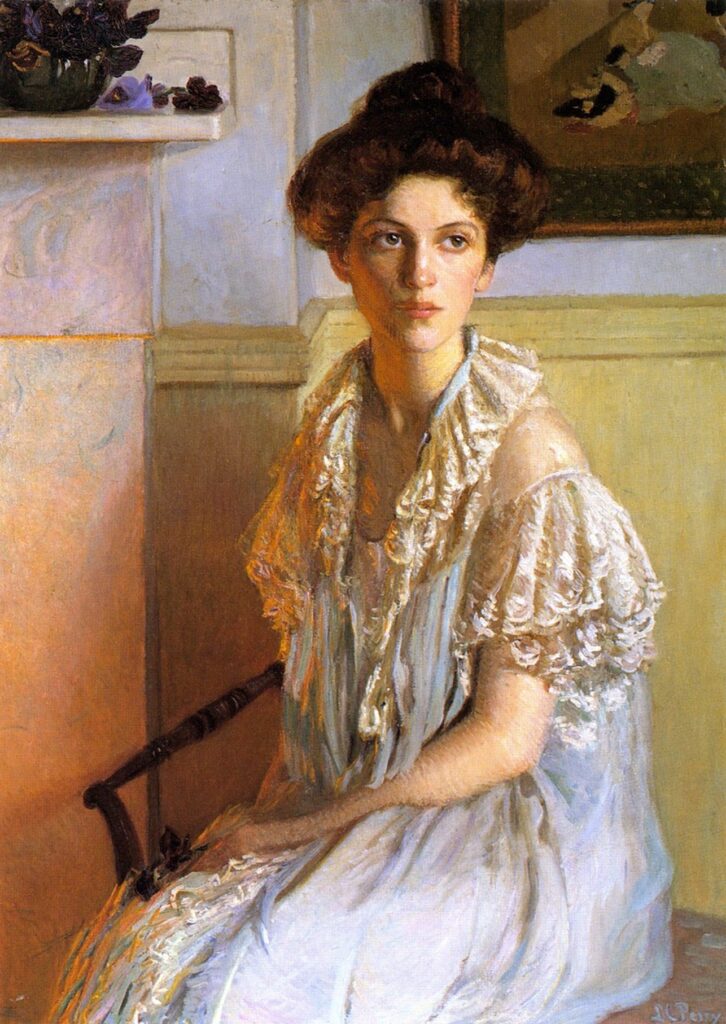 Lady with a Bowl of Violets, Lilla Cabot Perry, 1910. Oil on canvas. Image Courtesy of the National Museum of Women in the Arts, Washington, DC.
Lady with a Bowl of Violets, Lilla Cabot Perry, 1910. Oil on canvas. Image Courtesy of the National Museum of Women in the Arts, Washington, DC.
Her life in Giverny
Perry was also greatly influenced by Emerson’s transcendentalist philosophies and her friendship with the painter Claude Monet (1840-1926), whom she met in Paris in 1889. Inspired by Monet, Perry and her family spent nine summers between 1889 and 1909 in Giverny where he lived. Perry’s portrait, Study of Light and Reflection (1891) and the landscape painting, Haystacks, Giverny (1896), the latter painted in the French Impressionist en plein air style, clearly evince the influence of Monet.
 Study of Light and Reflection, Lilla Cabot Perry, 1891. Oil on canvas. Image courtesy of the Athenaeum.
Study of Light and Reflection, Lilla Cabot Perry, 1891. Oil on canvas. Image courtesy of the Athenaeum.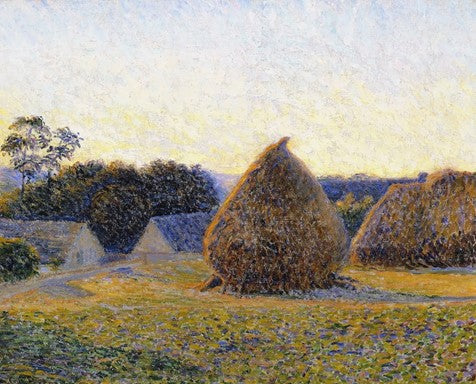 Haystacks, Giverny, Lilla Cabot Perry, 1896. Oil on canvas. Image courtesy of Galerii de Arta.
Haystacks, Giverny, Lilla Cabot Perry, 1896. Oil on canvas. Image courtesy of Galerii de Arta.
Explore the Masters
12th century Art
13th Century Art
14th Century Art
14th century B.C. Art
15th century Art
16th century Art
17th century Art
18th century Art
19th century Art
1st-century BC Art
20th century Art
21st Century Art
2nd century Art
2nd Century BC Art
2nd Century CE Art
3nd Century Art
4th century BC Art
5th century BC Art
6th century B.C. Art
7th centry Art
7th century B.C. Art
9th century B.C. Art
African Art
AI Art
Albanian Art
Algerian Art
American Art
Ancient Art
Argentine Art
Armenian Art
Art Movements and Styles
Art Quotes — Literature
Australian Art
Austrian Art
Awarded Artist
Azerbaijani Art
Baroque Era style
Belgian Art
Blogger
Bohemian Art
Bolivian Art
Bosnian Art
Brazilian Art
British Art
British Museum
Brooklyn Museum
Bulgarian Art
Burmese Art
Cambodian Art
Canadian Art
Catalan Art
Chilean Art
Chinese Art
Christie’s
Cleveland Museum of Art
Colombian Art
Croatian Art
Cuban Artist
Czech Art
Danish Art
Digital art
Dominican Artist
Dutch Art
Ecuadorian Artist
Egyptian Art
Estonian Artist
Fai da te Art Blogger
Filipino Art
Finnish Art
Flemish Art
French Art
Genre painter
Georgian Artist
German Art
Greek Art
Guatemalan Artist
Haitian Artist
Hawaii Art
Hermitage Museum
Hudson River School
Hungarian Art
Impressionist art movement
Indian Art
Iranian Art
Iraqi Art
Irish Art
Israeli Artist
Italian Art
Japanese Art
Jewish Artist
Kazakhstani Artist
Korean Art
Kurdish Art
Latin American Artist
Latvian Artist
Lebanese Artist
Libyan Artist
Lithuanian Artist
Macedonian Art
Macedonian Artist
Maltese Art
Metropolitan Museum of Art
Mexican Art
Moldovan Artist
Moma
Mongolian Artist
Moroccan Artist
Musée d’Orsay
Musée du Louvre
Museo del Prado
Museo Thyssen-Bornemisza
Museum Barberini
Museum Masterpieces
MusicArt
National Gallery London
National Gallery of Art Washington
Netherlandish Art
Netherlandish Artists
New Mexico Artist
New Zealand Art
Nigerian Artist
Norwegian Art
Pakistani Artist
Paris painting
Peruvian Art
Photographer
Polish Art
Politica dei cookie
Portuguese Artist
Post-Impressionism
Realist Artist
Renaissance Art
Rijksmuseum
Romanian Art
Royal Academy
Russian Art
Scottish Art
Sculptor
Senegalese Artist
Serbian Artist
Singaporean Art
Sitemaps
Slovak art
Slovenian Art
Sotheby’s
South African Art
Spanish Art
Swedish Art
Swiss Art
Syrian Artist
Taiwanese Artist
Tate Britain
Thailand Artist
The Samuel Kress Collection
Tibetan Artist
Turkish art
Uffizi Gallery
Ukrainian Art
Uruguayan Artist
Van Gogh Museum
Vatican Museums
Venezuelan Art
Victoria and Albert Museum
Vietnamese Art
Welsh Art
Women Artists
Frequently Asked Questions.
Where did Lilla Cabot Perry live?
Lilla Cabot Perry enjoyed a blooming career during the 1900s. Born in Boston, the artist traveled and rented houses in multiple places, including Belgium, Paris, Netherlands, England, Tokyo, and Giverny, and at last bought a farm in Hancock to settle forever.
When was Lilla Cabot Perry born?
Lilla Cabot Perry was born on 13 January 1848 to a patrician family in Boston, Massachusetts.
Advertisement
What type of paintings did Lilla Cabot Perry paint?
The early paintings of Lilla Cabot Perry exhibit her excellence in portraiture; however, as the artist took her influence from Impressionism, especially Claude Monet, her later works transitioned to Landscape art.
Looking at the Artworks of Lilla Cabot Perry.
The earliest painting of Lilla is a small oil portrait of her daughter Margaret, Portrait of an Infant. Dating back to 1878, it indicates that this is just an allude to the informal sketching sessions with friends as early as eleven. She painted it when she did not receive any informal instruction and learned by herself, resulting from close observation of family and friends. With blunt contours and a little use of light and shadow, the artist emphasizes the baby’s curiosity over the flower she holds.
Advertisement
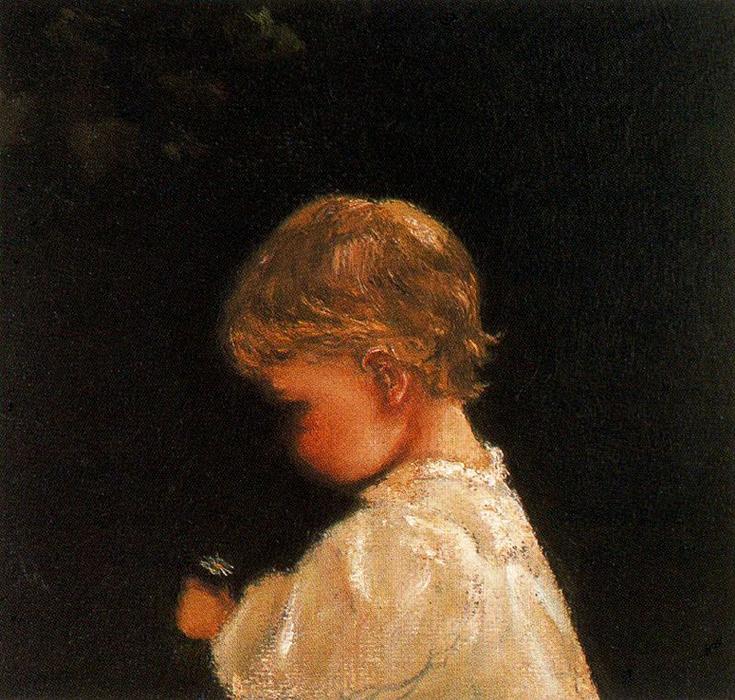
Portrait of an Infant by Lilla Cabot Perry | Source: Lilla Cabot Perry, Public domain, via Wikimedia Commons
In another painting, Perry’s portrait of Margaret with her violin, titled The Beginner, ca 1885-86, and Collin’s portrait of young Alexander Wetherill. With each work, the dark background tones accentuate the emphasis on character expressed through the serious and intent gazes of the children. Serious, intent, wistful, soulful, the children rarely smiled.
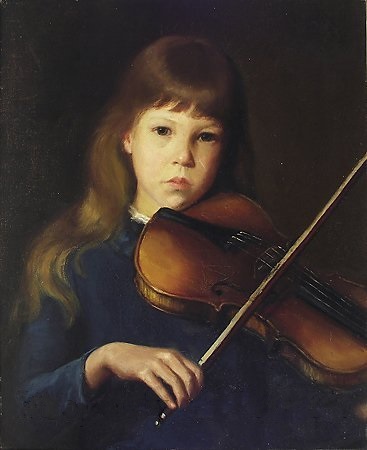
The Beginner by Lilla Cabot Perry | Source: Lilla Cabot Perry, Public domain, via Wikimedia Commons
A major and radical transformation in Perry’s style took place during the first summer at Giverny, depicting the little French peasant Angele- Petite Angele, I and Petite Angele, II. By applying bright pigments directly to her canvas, Lilla employed the Impressionist broken color technique. In this photograph, mustard yellow and spinach green leaves contrast with the vermilion red flowers to enhance the impression of sunlight streaming in the window. Contrary to Perry’s earlier academic portraits, Angele’s face is rendered in variegated flesh tones. Perry might have been most concerned with capturing the “sunlight shining through some geraniums” in this painting. Angele’s wistful gaze, however, recalls Emerson’s reflections on the quest for unity and the manifestation of spiritual truth viewed through a child’s innocent eyes and heart.
Advertisement

La Petite Angele II by Lilla Cabot Perry | Source: Lilla Cabot Perry, Public domain, via Wikimedia Commons
We do not know whether Lilla received any formal instruction in the pastels, but she showed great proficiency in the oil. Child in Kimono is one of the earliest pastels of the artist, which depicts Alice Perry. White Bed Jacket is another admirable example in this same niche. In both media, she sought to add complexity offered through the rendering of lace, fur, satin, velvet, and transparent fabrics.

Child in Kimono by Lilla Cabot Perry | Source: Via WikiArt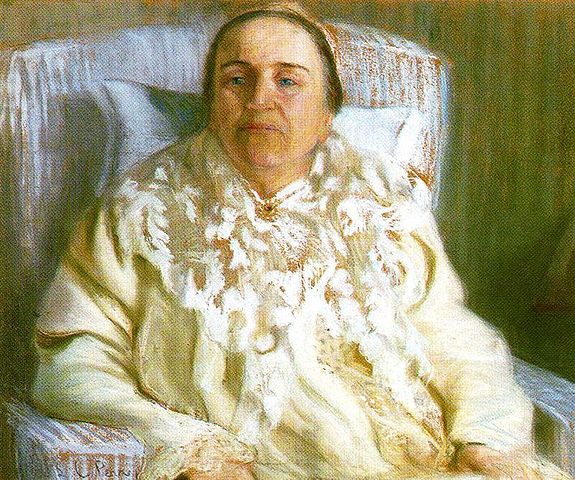
White Bed Jacket by Lilla Cabot Perry | Source: Lilla Cabot Perry – 1905, Public domain, via Wikimedia Commons
Occasionally, the artist’s work uses a pensive mood, which sometimes merges into melancholy. The landscapes that Perry painted in France, Japan, and New Hampshire, in contrast to some of her figures, convey less complicated messages and are usually painted to express her joy at the variety of seasons and light of France and New Hampshire. In her snowscapes, she painted New Hampshire mountains at sunrise, sunset, or in mist or snow.
Advertisement
During her last stay in France, Lilla painted two mesmerizing impressionist works. The two are Little Girl in a Lane and Violoncellist.
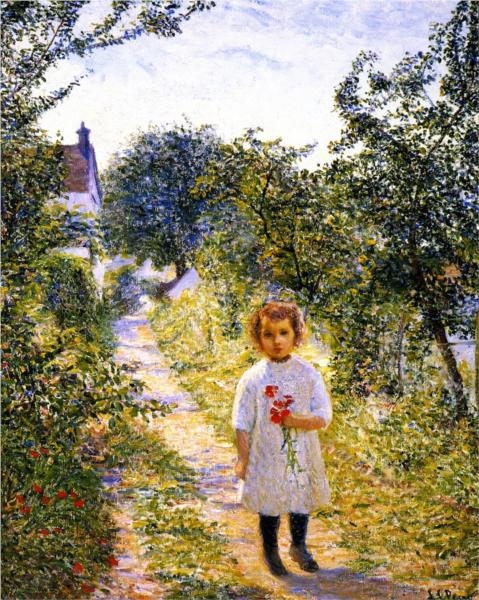
Little Girl in a Lane by Lilla Cabot Perry | Source: Via WikiArt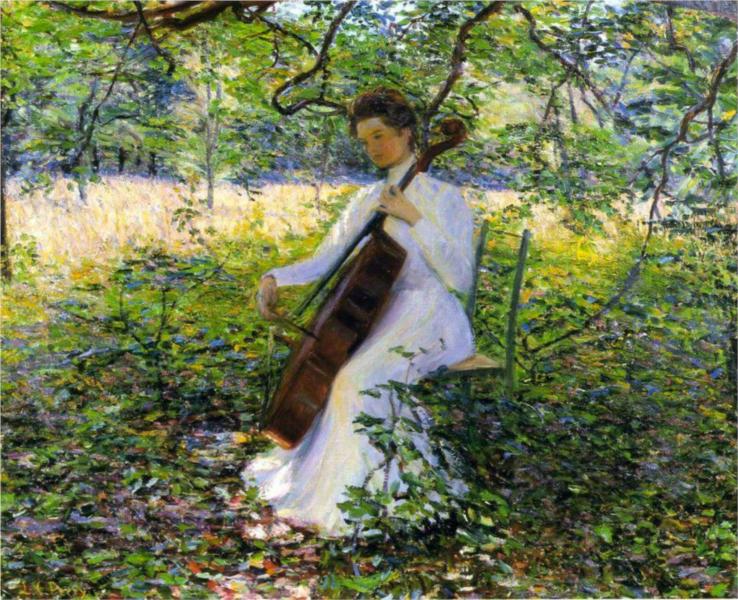
Violoncellist by Lilla Cabot Perry | Source: Via WikiArt
The Legacy
Perry’s vocal advocacy of the Impressionist movement paved the way for other American Impressionists like Mary Cassatt to gain the exposure and reception they needed in the United States. She furthered the American careers of her close friends Claude Monet and Camille Pissarro by lecturing stateside on their talents and showcasing their works. Her efforts helped lead to the acceptance of Impressionism as an art form in America. While she did not receive formal training until the age of thirty-six, Perry’s blending of eastern and western aesthetics and her sensitive visions of the feminine and natural worlds offered significant stylistic contributions to both the American and French Impressionist schools. She may be remembered most by keenly observed portraits, mostly of women and many commissioned to help support the family when her inheritance ran out.
Her Other Accomplishments
Perry completed several hundred paintings over her lifetime and was working up until her death at age 85 in 1933. Among other accomplishments, she published three books of poetry–The Heart of the Weed (1887), Impressions: A Book of Verse (1898), and The Jar of Dreams (1923)–and translated the Greek text, From the Garden of Hellas into English in 1891. Throughout her career, Perry was always active in local artistic communities and promoted the Impressionist style wherever she lived. In 1914, she helped found the Guild of Boston Artists to advance accomplished painters and sculptors, serving as a board member and its first secretary. In 1922, she had her first solo exhibition in New York.
Artist Abstract: Lilla Cabot Perry.
Lilla Cabot Perry started her art studies when art was on its verge of expansion and technology was about to transform the shape of American life. The first class of the artist came ten years after Alexander Graham Bell created the successful telephone message. Born into a patrician family in Boston, Massachusetts, on 13 January 1848, she emerged as a stalwart modernist in the arts. In Boston, she had an upbringing with the academic style of art, but her openness to change the erupts in Impressionist detail, and the unusual perspectives of Japanese art made her a good artist. Married to Professor Thomas Sergeant Perry, who was a specialist in 18th-century English literature, in 1874, she had three daughters. In her later life, she spent nine summers with her family in Giverny, renting a house close to Monet. Lilla highly promoted impressionism in America by encouraging the collectors and lecturing on Monet at the Boston Art Student Association in 1894. She was a founder and member of the Guild of Boston Artists in 1914, a member of the Allied Artists Association, London, the American Federation of Arts, the International Society of Arts and Letters, and the Women’s International Art Club.
Advertisement
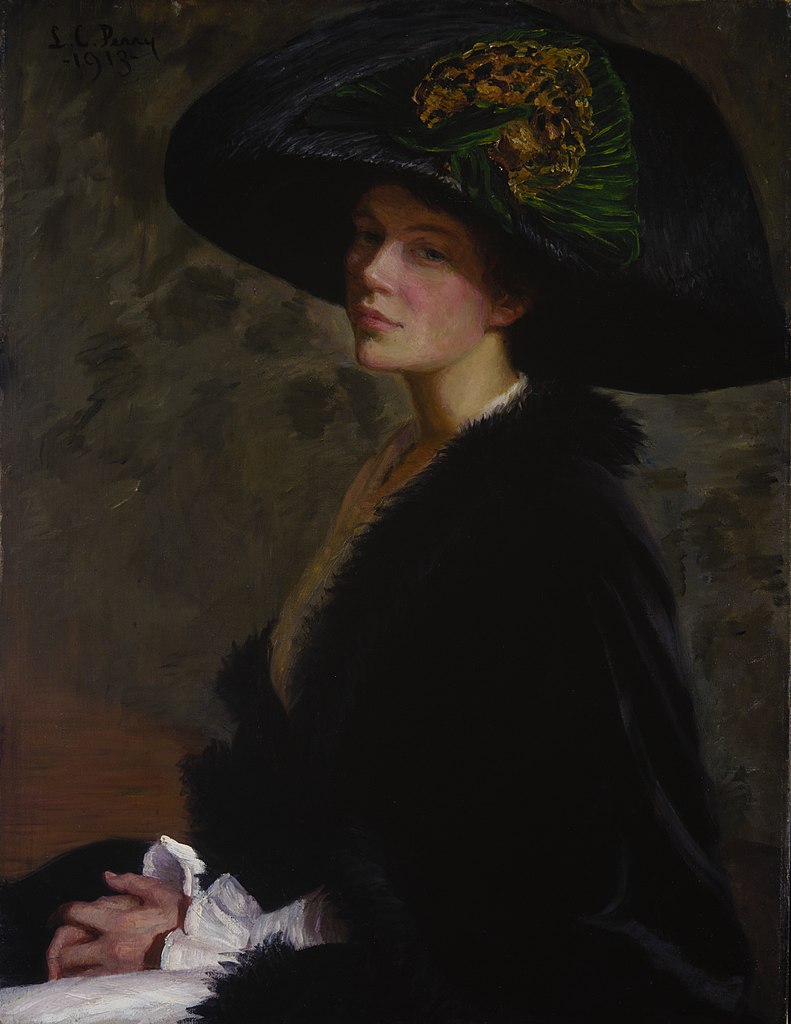
The Green Hat by Lilla Cabot Perry, Self Portrait | Source: Lilla Cabot Perry, Public domain, via Wikimedia Commons
| Artist | Lilla Cabot Perry |
| Birth | 13 January 1848 |
| Death | 28 February 1933 |
| Nationality | American |
| Genre | Landscape painting, Portraiture |
| Period | Modernism, Impressionism |
| Famous Paintings | Landscape in Normandy and Portrait of Thomas Sergeant Perry |





























